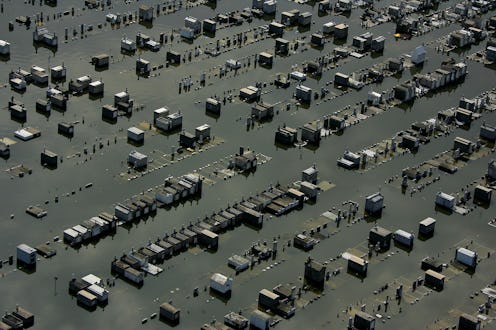News
How Hurricane Irma Might Compare To One Of The Deadliest In U.S. History

Another major hurricane is headed toward the United States with each passing day its likely trajectory and intensity upon impact become clearer. The National Hurricane Center says it could be a "potentially catastrophic" storm that seems to be taking aim at the Caribbean Islands and southern Florida. It's possible that Irma will be as bad as Katrina, but until the storm hits, there's no way to be certain.
There's now widespread fear that Irma could be the first hurricane to make landfall on the United States mainland as a Category 5 storm in decades. The NHC predicts that the storm will continue heading northwest for the next few days and hit Puerto Rico plus the northern coasts of the Dominican Republic, Haiti, and Cuba. Then on Saturday, the storm may turn to move straighter north and potentially run along the length of Florida.
The storm's trajectory certainly has the potential to create a lot of devastation, but the legacy of Katrina is just as much about the history of New Orleans and the federal government at the time as it is about the hurricane itself. Katrina was a strong storm — it hit New Orleans at Category 3 strength — but the city was also physically vulnerable due to poorly designed and crafted levees, according to The Washington Post. FEMA also didn't fully meet the state government's requests for buses, leaving thousands trapped in the sunken city for weeks.
If Irma causes similar physical damage to southern Florida, the federal government's recent experience with Hurricane Harvey will both help and hurt. Houston will have been a test run in some ways, and the emergency management process could be even more successfully implemented for Irma. However, the two nearly simultaneous disasters will stretch resources so thin that it will be daunting to meet everyone's needs.
Both hurricanes also took aim at socioeconomically vulnerable areas, so the recovery process from Irma may entail similar challenges to those Katrina victims faced. Miami and Tampa had the two lowest median household incomes of any cities in the country in 2014, according to the Census Bureau. Puerto Rico expects to be without power for three to four months, due to its ongoing financial problems. Victims will be fully reliant on government resources while they rebuild, raising the public cost of recovery.
After Katrina, the U.S. received millions in aid from foreign countries, as well as offers of help reengineering New Orleans. Not only has that not happened with Harvey, but there's almost no chance of the U.S. receiving aid if other more impoverished countries are similarly affected by Irma as well. Obviously resources should go where they are most needed, but that means the American people will have to make up the difference.
Finally, there's the fact that the affected region is completely unprotected from the ocean. There are no barrier islands like there are in Texas and Louisiana, so the full force of the storm would hit the Atlantic coast.
"If a Katrina directly hit Miami, you are talking about damages that could be several multiples of what happened in New Orleans," Greg Baecher, a professor of engineering at the University of Maryland, told CNBC on the 10th anniversary of Katrina. "First, you have the size of the city, and the fact that there is nothing between the coast and the ocean."
Irma may very well be the worst hurricane in U.S. history, but speculating on this issue isn't going to do anyone any good. The best thing you can do is try to gather your emergency supplies if you live in the affected area and be ready to mobilize if or when the situation demands, no matter where you live.